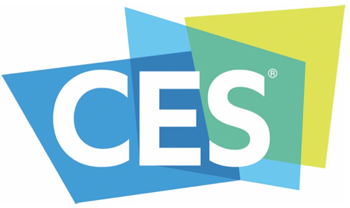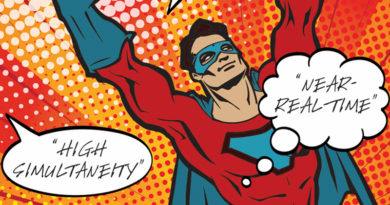CES 2019: A Curator’s Curation
By Leslie Ellis
In nearly 20 years of leading tours around the Consumer Electronics Show, I hereby declare the 2019 CES the best ever. Why? Because I had the good fortune to participate in an experiment: to see whether it’s possible to cover a show the size of CES — 180,000 attendees, 4,500 exhibitors, nearly 3 million square feet of exhibit space — without actually being in Las Vegas. Two weeks after Christmas.
The background: In 2001, CTAM hosted its first-ever CES tours. The tours morphed over the years, but in general they spanned two days, with two sets of about 30 attendees, comprising a (roughly) 50/50 mix of cable operators and content providers. Reasoning that the industry’s executive marketeers and business developers needed to see what the CE industry was cooking up for in-home use, we crafted a highly curated tour that cut through the crowds and the sensory overload, directly to subject matter experts. Heavy logistics on the front end — a bus, to slipstream between venues; meals; appointments; headsets; narration; guest speakers; badge wrangling — made it an easy, “follow me” experience that was ultimately fun and informative.
There was the year it snowed; there was the year (2018!) when the electricity suddenly groaned off, as a result of heavy rain on the LVCC roof. There was the year David Caruso made a very odd appearance, and the years (many years!) we volunteered Joe Rooney, then CMO of Cox, the “who wants to try it?” guy, donning everything from a brainwave reader to a video viewing cap.
Over time, CES becomes a rhythm that starts around Thanksgiving, crests during Christmas, and concludes the week after the New Year. Which is why it didn’t break my heart to actually experience a holiday break unfettered with the patter of appointment confirmations and tour administrivia.
And, because so much of CES is prep work that necessarily includes staying in lockstep with likeminded professionals — which can be done remotely — the work of curating this year’s CES for the annual CTAM webcast was different, but doable. For this edition of Nerdy Little Secrets, I checked in with dozens of SMEs, and kept close tabs on media coverage, to find the essence for you. Consider it a CES curation from someone who spent the last 19 years doing just that, every November-January.
Here we go…
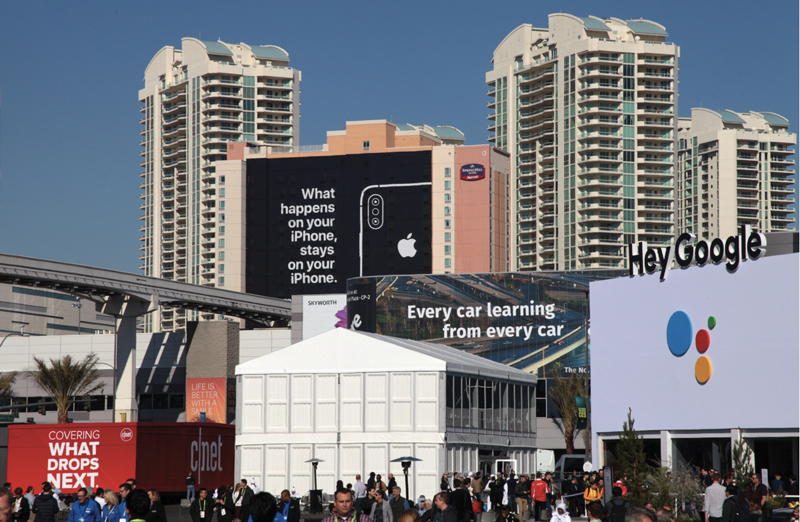
Las Vegas, Nevada, Apple billboard at CES 2019
The Keynotes
When moving 30+ people in and out of anywhere, it’s wise to avoid events involving long lines, like keynotes. But a look at the Big Speaker makeup of this year’s CES is a bit of a “show-verview” in and of itself. Representatives included a semiconductor company (AMD), two telcos (Verizon and AT&T), an AI heavyweight (IBM) and, perhaps so as not to forget its roots, a CE company (LG.) Also notable: after considerable grousing last year about the lack of gender diversity amongst the keynotes, this year’s mix included three women. (Excellent recovery, CTA. Keep going!)
CES and Network Connectivity
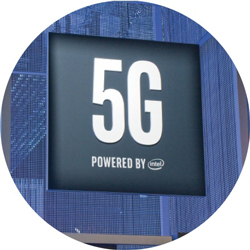 I don’t think I’ve seen a CES with such a heavy emphasis on network connectivity, and especially mobile (as opposed to Wi-Fi). This was the year of 5G, where the “G” stands for “generation,” not “giga”-anything. Executives with AT&T and Verizon used hyperbolic language like “it’ll change everything!” and “it’s the fourth industrial revolution,” promising 5G as “the backbone for transportation, virtual reality, sports technology and digital health.”
I don’t think I’ve seen a CES with such a heavy emphasis on network connectivity, and especially mobile (as opposed to Wi-Fi). This was the year of 5G, where the “G” stands for “generation,” not “giga”-anything. Executives with AT&T and Verizon used hyperbolic language like “it’ll change everything!” and “it’s the fourth industrial revolution,” promising 5G as “the backbone for transportation, virtual reality, sports technology and digital health.”
This is why 5G increasingly strikes me as a kind of wishful Swiss Army knife — except so far it’s just the case, with lots of placeholders to stash the dozens of tools it will supposedly enable, from faster speeds to low power IoT connectivity to a “wireless last mile” that can walk the dog. (Just seeing if you’re paying attention. 5G will never walk your dog. Pretty sure.)
It’s also why CableLabs and the NCTA blitzed with word of “10G,” where the “G” stands for “gigabits.” Short version: 10G is essentially synonymous with full duplex (FDX) DOCSIS, which is the next chapter of the DOCSIS 3.1 specification. FDX is aimed at connections that move 10 Gbps, bidirectionally, which will matter to things that need crazy-fast speed and low latency. So: Expect to hear lots more about what will be positioned as “a 10G platform” as the year unfolds, and as FDX (and 5G) gets closer to the deployment mainstream. (By most accounts, 10G is a 2020 thing. 5G appears to be equal parts today, tomorrow, later this year, and 2020.)
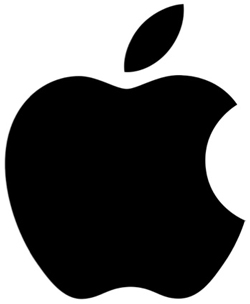 Apple and CES
Apple and CES
Apple doesn’t believe in CES, and never has — or, at least, they’ve never exhibited. That’s why this year’s announcement that Samsung and Visio will integrate with AirPlay2 made headlines that once again positioned Apple as a pervasive vibe at a CES. (Much easier on the marketing budget, too. Although news coverage also swooped in on the 13-story Apple ad affixed to the exterior of the Springhill Suites.)
Oh, Yeah — TVs!
CES is traditionally heavy on high-glam TV screens. When the CTAM tours began, HD was an infant, but its preponderance made the industry’s bandwidth overseers jumpy — because HD signals needed so much of it. Then 3D tried to happen, and 4K happened. The network didn’t buckle because of parallel advancements in compression technologies, but each new leap in display technologies usually requires more bandwidth than the one before it.
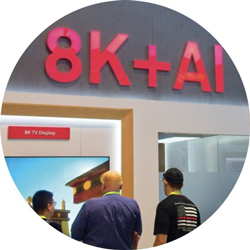 Which brings us to 8K, which uses 4x more pixels than 4K. A hot-ticket topic at this year’s CES, as evidenced by the formation of an 8K Association, and five CE vendors (Samsung, Sony, Toshiba, Hisense, LG) which showcased 8K sets as part of their show sizzle. The whole thing reminded me of a column I wrote in 2013, titled “You Have Eight Years to Move the Bookcase.” Why, because advancements in resolution are best observed on bigger and bigger screens. Example: Samsung, which unveiled a 219-inch (on the diagonal) screen, aptly named “Wall TV.” Besides the price (“if you have to ask, you can’t afford it” plays well here), a screen that big would need about 18 feet of wall.
Which brings us to 8K, which uses 4x more pixels than 4K. A hot-ticket topic at this year’s CES, as evidenced by the formation of an 8K Association, and five CE vendors (Samsung, Sony, Toshiba, Hisense, LG) which showcased 8K sets as part of their show sizzle. The whole thing reminded me of a column I wrote in 2013, titled “You Have Eight Years to Move the Bookcase.” Why, because advancements in resolution are best observed on bigger and bigger screens. Example: Samsung, which unveiled a 219-inch (on the diagonal) screen, aptly named “Wall TV.” Besides the price (“if you have to ask, you can’t afford it” plays well here), a screen that big would need about 18 feet of wall.
Also a 2019 CES darling: LG’s rollable OLED, a super-thin, pliable, 65-inch screen that slides up from a console. When it’s all rolled up, not being a TV, it’s an audio console that looks like a bench, but with a built-in sound bar (and specifically, a 4.2 channel, 100-watt, front-firing one, from Dolby Atmos.) No pricing yet, but available “in the second half of the 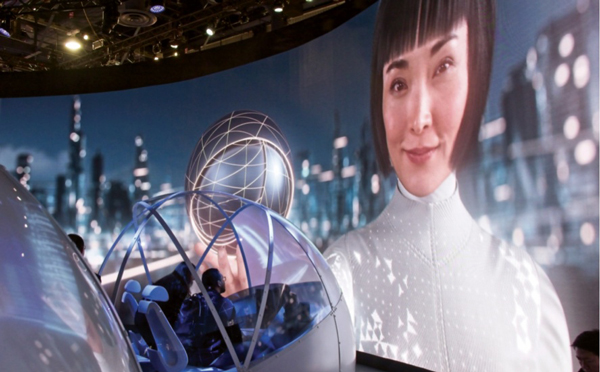 year.”
year.”
So much more: The IoT (everywhere), artificial intelligence (also everywhere), the Google/Amazon voice control vibe, an automotive section bigger than automotive shows, odd gadgetry, smart cities, VR/AR, and peace-of-mind advancements — among them Comcast’s AI-fueled security additions to its xFi portfolio, announced at the show — I could go on and on. (But I won’t.)
The reason why CES is relevant is this: If there’s one thing all of the stuff of CES is going to need, now and forever, it’s a broadband connection that’s super-fast, reliable, and ready for whatever it needs to move.
CES exhibit from Hyundai, promoting advances in automated vehicle technology.
 Leslie Ellis,
Leslie Ellis,
President,
Ellis Edits Inc.
leslie@ellisedits.com
Leslie Ellis is a tech writer focused on explaining complex engineering stuff for people who have less of a natural interest than engineers. She’s perhaps best known (until now!) for her long-running weekly column in Multichannel News called “Translation Please.” She’s written two broadband dictionaries, one field guide to broadband, and is a behind-the-scenes tech translator for domestic and global service providers, networks, and suppliers. She’s served as board member of the Rocky Mountain chapter of the SCTE since 2015, and is a 2019 Cable Hall of Fame inductee.
Editorial credit: James Mattil (Hyundai, 8K+AI. 5G) / Shutterstock.com
Editorial credit: yvasa / Shutterstock.com

